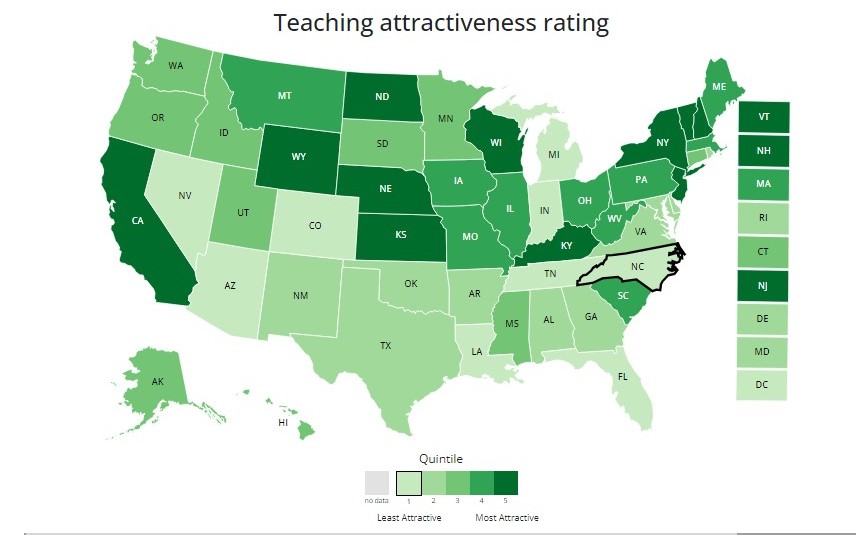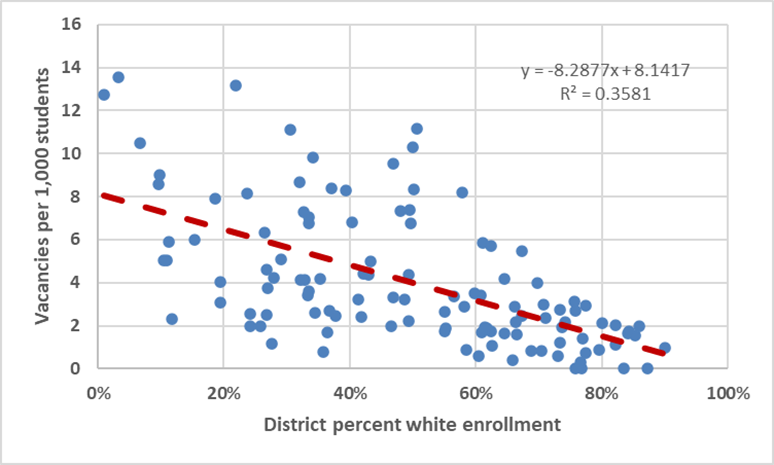New report highlights General Assembly’s policy failures
A new report from Learning Policy Institute provides important insight into how state policies impact the attractiveness of the teaching profession. The report examines each state’s record on teacher compensation, working conditions, school resources, turnover, and equitable distribution. Not surprisingly, North Carolina ranks among the least attractive states for teachers.
Most notably, the report gives North Carolina the worst marks in the following categories:
Starting salary
- Teacher dissatisfaction
- Test-related job insecurity
- Expenditures per-pupil
- Percentage of teachers indicating they plan to leave the profession
- Percentage of uncertified teachers
- Uncertified teachers in higher-minority schools
- Uncertified teachers in higher-poverty schools
- Gap in percentage of uncertified teachers between higher- and lower-poverty schools
While the report notes large equity gaps based on certified teachers, the state receives positive ratings for its relatively equitable distribution of experienced teachers. These findings undermine the arguments of those who wrongly claim that North Carolina’s unique funding system drives inequitable “teacher sorting.”
North Carolina is one of the country’s least attractive states for teachers
North Carolina’s poor ratings come as no surprise. General Assembly leadership has spent the last decade enacting policies that make the state inhospitable to teachers.
Pay and Benefits
- Average teacher pay has fallen from 11% below the national average in 2008-2009 to 19% in 2023-2024
- Teacher starting salary ranks 41st in the nation, behind states like West Virginia, South Carolina, Alabama, and Mississippi
- The elimination of career status in 2013 authorized districts to fire teachers for arbitrary reasons and created a chilling effect on teachers advocating for policies that would benefit their students
- The same year, leaders eliminated the 10 percent salary supplement for teachers newly earning a master’s degree
- In 2014, legislators sought to push experienced teachers out of the classroom by eliminating longevity pay and lowering the base pay for teachers with higher levels of experience
- In 2017, legislators pivoted toward making teaching less attractive to new hires by eliminating eligibility for retiree health care benefits
In the classroom
- Leaders added measures of standardized tests to teacher evaluations, dissuading teachers from serving students with higher needs and narrowing curricular focus
- During the pandemic, state leaders fought to push teachers back into overcrowded classrooms before the availability of vaccines and without any systematic efforts to improve or monitor air quality
- In recent years, state leaders have fanned the flames of bigoted moral panics against “critical race theory” and LGBTQ+ inclusivity to undermine public support of teachers and further chill efforts by schools to foster solidarity across our differences
- Legislative leaders have inserted themselves into the long-running Leandro court case to fight court orders to adequately and equitably fund public schools in ways that would dramatically improve working conditions for teachers
The inevitable outcome of the past decade’s policy decisions is that North Carolina is now one of the least attractive states in the country for teachers.
The clearest reflection of this is our state’s record levels of teacher vacancies. As our analysis has shown, teacher vacancies significantly correlate with student race and income.
2022-2023 district-level teacher vacancies (40th day) versus enrollment of white students
2024 legislative short session is a missed opportunity
General Assembly leaders could have addressed the pressing issue of teacher vacancies during the recent legislative short session. Unfortunately, instead of boosting teacher salaries to competitive levels or improving working conditions by implementing the Leandro Plan, General Assembly leaders pursued further expansion of privatization schemes that further segregate students and siphon much-needed funding.
While legislators did not secure additional voucher expansion funding this year after failing to pass a budget, North Carolina’s public schools still face serious obstacles.
A way forward for public education
Fortunately, the LPI report shows that North Carolina doesn’t have to keep on this destructive path. It notes several states that have made strides toward improving teacher attractiveness in ways that are paying off for students.
For example, California invested in making teacher salaries competitive with other industries, improving classroom conditions, and growing a diverse teaching force. Unlike in North Carolina, California’s leaders have worked to foster collegial working environments that grant teachers autonomy. As a result:
“In less than a decade after it undertook these reforms, California leapt from 48th in the nation in 8th-grade reading achievement to the national average, gaining more ground than any other state, and also improved in math achievement, especially increasing performance for students from low-income families.”
There is nothing stopping North Carolina’s leaders from pursuing an education agenda that benefits students by strengthening the teaching profession. North Carolina’s school funding effort—the amount we spend on schools relative to the size of our economy—ranks dead last in the nation. This shows that North Carolina can afford to make the investments proven to boost student performance.
Now we need legislative leaders with the political will to act on behalf of our public schools.
 Justice Circle
Justice Circle 
